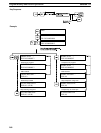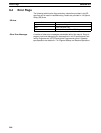
!
162
8-1 Introduction
The K-type PCs provide self-diagnostic functions to identify many types of
abnormal system conditions. These functions minimize downtime and enable
quick, smooth error correction.
This section provides information on hardware and software errors that occur
during PC operation. Program input and program syntax errors are described
in
Section 4 Writing and Inputting the Program
. Although described in
Section
3 Memory Areas
, flags and other error information provided in SR areas are
listed in
8-4 Error Flags
.
There are two indicators on the front of the CPU that provide visual indication
of an abnormality in the PC. The error indicator (ERR) indicates fatal errors
(i.e., ones that will stop PC operation); the alarm indicator (ALARM) indicates
nonfatal ones. These indicators are shown in
2-2 Indicators
.
DANGER The PC will turn ON the error indicator (ERR), stop program execution, and turn
OFF all outputs from the PC for most hardware errors, or certain fatal software
errors. PC operation will continue for all other errors. It is the user’s responsibility
to take adequate measures to ensure that a hazardous situation will not result
from automatic system shutdown for fatal errors and to ensure that proper
actions are taken for errors for which the system is not automatically shut down.
System flags and other system and/or user-programmed error indications can
be used to program proper actions.
8-2 Reading and Clearing Errors and Messages
System error messages can be displayed on the Programming Console or
any other Programming Device.
On the Programming Console, press the CLR, FUN, and MONTR keys. If
there are multiple error messages stored by the system, the MONTR key can
be pressed again to access the next message. If the system is in PROGRAM
mode, pressing the MONTR key will clear the error message, so be sure to
write down all message errors as you read them out. (It is not possible to
clear an error or a message while in RUN or MONITOR mode; the PC must
be in PROGRAM mode.) When all messages have been cleared, “ERR CHK
OK” will be displayed.
Details on accessing error messages from the Programming Console are
provided in
7-3 Monitoring Operation and Modifying Data
. Procedures for the
GPC, LSS, and FIT are provided in the relevant
Operation Manual
.
8-3 Error Messages
There are basically two types of errors for which messages are displayed:
non-fatal operating errors, and fatal operating errors.
The type of error can be quickly determined from the indicators on the CPU,
as described below for the two types of errors. If the status of an indicator is
not mentioned, it makes no difference whether it is lit or not.
After eliminating the cause of an error, clear the error message from memory
before resuming operation.
Error Messages Section 8-3


















